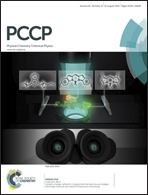Ab initio molecular dynamics simulations of aqueous triflic acid confined in carbon nanotubes†
Abstract
Ab initio molecular dynamics simulations were performed to investigate the effects of nanoscale confinement on the structural and dynamical properties of aqueous triflic acid (CF3SO3H). Single-walled carbon nanotubes (CNTs) with diameters ranging from ∼11 to 14 Å were used as confinement vessels, and the inner surface of the CNT were either left bare or fluorinated to probe the influence of the confined environment on structural and dynamical properties of the water and triflic acidic. The systems were simulated at hydration levels of n = 1–3 H2O/CF3SO3H. Proton dissociation expectedly increased with increasing hydration. Along with the level of hydration, hydrogen bond connectivity between the triflic acid molecules, both directly and via a single water molecule, played a role on proton dissociation. Direct hydrogen bonding between the CF3SO3H molecules, most commonly found in the larger bare CNT, also promoted interactions between water molecules allowing for greater separation of the dissociated protons from the CF3SO3− as the hydration level was increased. However, this also resulted in a decrease in the overall proportion of dissociated protons. The confinement dimensions altered both the hydrogen bond network and the distribution of water molecules where the H2O in the fluorinated CNTs tended to form small clusters with less proton dissociation at n = 1 and 2 but the highest at n = 3. In the absence of nearby hydrogen bond accepting sites from H2O or triflic acid SO3H groups, the water molecules formed weak hydrogen bonds with the fluorine atoms. In the bare CNT systems, these involved the CF3 groups of triflic acid and were more frequently observed when direct hydrogen bonding between CF3SO3H hindered potential hydrogen bonding sites. In the fluorinated tubes, interactions with the covalently bound fluorine atoms of the CNT wall dominated which appear to stabilize the hydrogen bond network. Increasing the hydration level increased the frequency of the OH⋯F (CNT) hydrogen bonding which was highly pronounced in the smaller fluorinated CNT indicating an influence on the confinement dimensions on these interactions.


 Please wait while we load your content...
Please wait while we load your content...